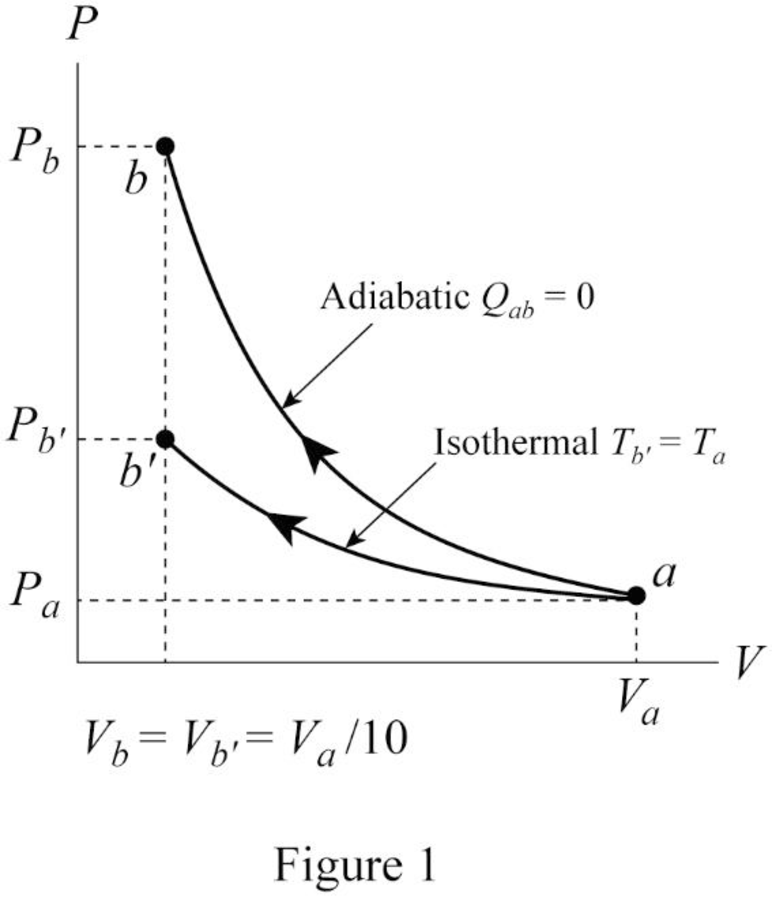
(a)
The work done on the gas in an isothermal process.
(a)
Answer to Problem 52P
Thework done on the gas in an isothermal process is
Explanation of Solution
Write the expression for the work done on the gas,
Here,
For the isothermal process, the work done on the gas,
Here,

Conclusion:
Substitute
Therefore, the work done on the gas in an isothermal process is
(b)
Thework done on the gas in an adiabatic process.
(b)
Answer to Problem 52P
Thework done on the gas in an adiabatic process is
Explanation of Solution
Write the expression for the temperature of the system at point
Here,
Write the expression for the molar specific heat at constant volume,
Here,
Write the expression for the work done on the gas in an adiabatic process,
Here,
Conclusion:
Substitute
Substitute
Substitute
Therefore, the work done on the gas in an adiabatic process is
(c)
The final pressure of the gas in an isothermal process.
(c)
Answer to Problem 52P
The final pressure of the gas in an isothermal process is
Explanation of Solution
Write the expression for the
For the isothermal process,
Here,
Conclusion:
Substitute
Therefore, the final pressure of the gas in an isothermal process is
(d)
The final pressure of the gas in an adiabatic process.
(d)
Answer to Problem 52P
The final pressure of the gas in an adiabatic process is
Explanation of Solution
For the adiabatic process,
Write the expression for the final pressure of the gas,
Conclusion:
Substitute
Therefore, the temperature at the end of the cycle is
Want to see more full solutions like this?
Chapter 17 Solutions
Principles of Physics: A Calculus-Based Text
- An object is placed 24.1 cm to the left of a diverging lens (f = -6.51 cm). A concave mirror (f= 14.8 cm) is placed 30.2 cm to the right of the lens to form an image of the first image formed by the lens. Find the final image distance, measured relative to the mirror. (b) Is the final image real or virtual? (c) Is the final image upright or inverted with respect to the original object?arrow_forwardConcept Simulation 26.4 provides the option of exploring the ray diagram that applies to this problem. The distance between an object and its image formed by a diverging lens is 5.90 cm. The focal length of the lens is -2.60 cm. Find (a) the image distance and (b) the object distance.arrow_forwardPls help ASAParrow_forward
 Principles of Physics: A Calculus-Based TextPhysicsISBN:9781133104261Author:Raymond A. Serway, John W. JewettPublisher:Cengage Learning
Principles of Physics: A Calculus-Based TextPhysicsISBN:9781133104261Author:Raymond A. Serway, John W. JewettPublisher:Cengage Learning
 Physics for Scientists and Engineers: Foundations...PhysicsISBN:9781133939146Author:Katz, Debora M.Publisher:Cengage Learning
Physics for Scientists and Engineers: Foundations...PhysicsISBN:9781133939146Author:Katz, Debora M.Publisher:Cengage Learning Physics for Scientists and Engineers, Technology ...PhysicsISBN:9781305116399Author:Raymond A. Serway, John W. JewettPublisher:Cengage Learning
Physics for Scientists and Engineers, Technology ...PhysicsISBN:9781305116399Author:Raymond A. Serway, John W. JewettPublisher:Cengage Learning Physics for Scientists and EngineersPhysicsISBN:9781337553278Author:Raymond A. Serway, John W. JewettPublisher:Cengage Learning
Physics for Scientists and EngineersPhysicsISBN:9781337553278Author:Raymond A. Serway, John W. JewettPublisher:Cengage Learning Physics for Scientists and Engineers with Modern ...PhysicsISBN:9781337553292Author:Raymond A. Serway, John W. JewettPublisher:Cengage Learning
Physics for Scientists and Engineers with Modern ...PhysicsISBN:9781337553292Author:Raymond A. Serway, John W. JewettPublisher:Cengage Learning





